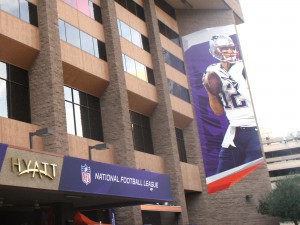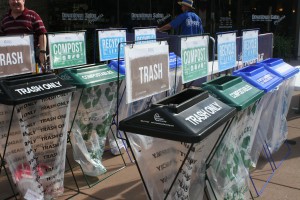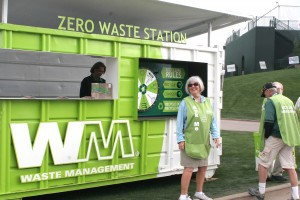- Slug: Sustainability-Events,550
- Photos available (thumbnails, captions below)
By SUMMER PAULI
Cronkite News
PHOENIX – A massive poster of New England Patriots quarterback Tom Brady covering one side of the Hyatt Regency Phoenix accounts for just some of the miles of Super Bowl-related vinyl gracing downtown.
There’s no need for extra landfill space to accommodate the posters when the big game is over, however. The NFL has partnered with Keep Phoenix Beautiful to use the vinyl as shade or liner beds in community gardens around the Valley.
In Glendale, the electricity powering University of Phoenix Stadium on Super Bowl Sunday will be from renewable sources thanks to a partnership with SRP.
Meanwhile, the estimated 500,000 fans attending the Waste Management Phoenix Open this week in Scottsdale won’t see garbage cans. Their beer cups, uneaten food and other waste will go in recycling and composting bins as part of the sponsor’s goal of zero waste.
With the two major events drawing huge crowds to Glendale, Phoenix and Scottsdale, organizers say minimizing the environmental impact is the right thing to do and taps into a national trend.
“Every major sports league has gotten involved in sustainability,” said Jack Groh, director of the NFL Environmental Program.
Aware of how much materiel the NFL brings to a Super Bowl host city, from carpeting in the NFL Experience at the Phoenix Convention Center to office supplies to building materials, the league partners with local groups including the Salvation Army to reuse rather than throw away, Groh said.
Some of the leftover items are sold, he added.
Meanwhile, the NFL has partnered with the nonprofit Waste Not to collect leftover food from Super Bowl events and distribute it to soup kitchens and churches. About 90,000 pounds of food was collected in 2008, the last time the Super Bowl was in Arizona.
Through the Urban Forestry Program, the NFL and volunteers plant thousands of trees in each Super Bowl host city with a stated goal of addressing climate change.
SRP partnered with the Arizona Super Bowl Host Committee to provide renewable energy for 100 percent of the game’s needs. In addition to wind energy powering the game, all facilities involved in the Super Bowl are using energy produced by renewable sources.
The Waste Management Phoenix Open, which bills itself as “the greenest show on grass,” is aiming for its third straight year of sending no waste to landfills.
There are 6,000 recycling and composting containers and 60 solar compactors with solar panels on top. The recyclable or compacted materials are sent to specialized facilities that recover waste.
To educate fans attending the tournament, there is an interactive Zero Waste Station where attendees can spin a wheel and choose whether the item the wheel lands on should be composted or recycled.
“Aluminum cans are recycled and back on the shelf within 60 days,” said Janette Micelli, external communications manager for Waste Management.
^___=

As part of its sustainability efforts, the NFL is partnering with local organizations to reuse miles of vinyl posters adorning downtown Phoenix turned into shade and planting bed liners for community gardens. (Cronkite News Photo by Summer Pauli)

Waste receptacles in downtown Phoenix encourages Super Bowl revelers to recycle and compost rather than sending waste to landfills. (Cronkite News Photo by Summer Pauli)

A Zero Waste Station at the Waste Management Phoenix Open allows attendees to learn more about recycling and composting. (Cronkite News Photo by Summer Pauli)